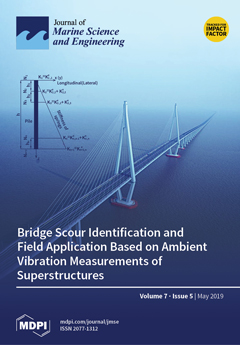Infragravity waves (frequency,
f = 0.005–0.05 Hz) are known to dominate hydrodynamic and sediment transport processes close to the shoreline on low-sloping sandy beaches, especially when incident waves are large. However, in storm wave conditions, how their importance varies on different beach types,
[...] Read more.
Infragravity waves (frequency,
f = 0.005–0.05 Hz) are known to dominate hydrodynamic and sediment transport processes close to the shoreline on low-sloping sandy beaches, especially when incident waves are large. However, in storm wave conditions, how their importance varies on different beach types, and with different mixes of swell and wind-waves is largely unknown. Here, a new dataset, comprising shoreline video observations from five contrasting sites (one low-sloping sandy beach, two steep gravel beaches, and two compound/mixed sand and gravel beaches), under storm wave conditions (deep water wave height, H
0 up to 6.6 m, and peak period, T
p up to 18.2 s), was used to assess: how the importance and dominance of infragravity waves varies at the shoreline? In this previously unstudied combination of wave and morphological conditions, significant infragravity swash heights (S
ig) at the shoreline in excess of 0.5 m were consistently observed on all five contrasting beaches. The largest infragravity swash heights were observed on a steep gravel beach, followed by the low-sloping sandy beach, and lowest on the compound/mixed sites. Due to contrasting short wave breaking and dissipation processes, infragravity frequencies were observed to be most dominant over gravity frequencies on the low-sloping sandy beach, occasionally dominant on the gravel beaches, and rarely dominant on the compound/mixed beaches. Existing empirical predictive relationships were shown to parameterize S
ig skillfully on the sand and gravel beaches separately. Deep water wave power was found to accurately predict S
ig on both the sand and gravel beaches, demonstrating that, under storm wave conditions, the wave heights and periods are the main drivers of infragravity oscillations at the shoreline, with the beach morphology playing a secondary role. The exception to this was the compound/mixed beach sites where shoreline infragravity energy remained low.
Full article





